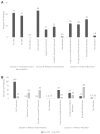Use of Medical Orders for Scope of Treatment for Heart Failure Patients During Postacute Care in Skilled Nursing Facilities
- PMID: 28688730
- PMCID: PMC5730449
- DOI: 10.1016/j.jamda.2017.05.021
Use of Medical Orders for Scope of Treatment for Heart Failure Patients During Postacute Care in Skilled Nursing Facilities
Abstract
Background: Individuals with heart failure (HF) who are hospitalized and admitted to skilled nursing facilities (SNFs) are at high risk for rehospitalization and death. The care preferences of this high-risk population have not been studied.
Objectives: To describe care preferences of patients with HF admitted to SNFs for rehabilitation based on Medical Orders for Scope of Treatment (MOST) documentation, and evaluate goal-concordant care based on MOST documentation, emergency department (ED) visits, and hospitalization.
Design, setting, and participants: Retrospective study of patients with HF in 35 SNFs enrolled in a randomized controlled trial of HF-disease management versus usual care between July 2014 and May 2016.
Measurements: Validity of MOST forms, care preference documentation, and ED visits/hospitalizations within 60 days of SNF admission.
Results: Of 370 patients (mean age 78.6 years, 58% women, 25% systolic HF), 278 (75%) had a MOST form in the SNF chart, of which 96 forms (35%) were invalid. The most common reason for an invalid MOST form was missing date accompanying patient or provider signature. Of 182 valid MOST forms, 47% of patients chose no cardiopulmonary resuscitation ("No CPR"), 58% selected "Full Treatment," 17% chose "Selective Treatment," and 23% chose "Comfort-Focused Treatment." Patients who were older [odds ratio (OR) = 1.50, 95% confidence interval (CI) = 1.25, 1.81] and female (OR = 2.33, 95% CI = 1.18, 4.59) had higher odds of choosing "No CPR." Sixty-six of 182 patients (36%) with valid MOST forms had an ED/hospital visit within 60 days of SNF admission; only 3 patients received medical care that was potentially discordant: all 3 chose "Comfort-Focused Treatment" and were hospitalized for more than symptom management.
Conclusion: Seventy-five percent of patients with HF admitted to SNFs had care preferences documented using the MOST form, and 95% received goal-concordant care based on care preferences documented during the SNF admission. Clinicaltrials.gov # NCT01822912.
Keywords: POLST; advance directives; goal-concordant care; heart failure; skilled nursing facility; subacute rehabilitation.
Copyright © 2017 AMDA – The Society for Post-Acute and Long-Term Care Medicine. Published by Elsevier Inc. All rights reserved.
Conflict of interest statement
The authors declare no conflicts of interest.
Figures
References
-
- Kociol RD, Hammill BG, Fonarow GC, et al. Generalizability and longitudinal outcomes of a national heart failure clinical registry: Comparison of Acute Decompensated Heart Failure National Registry (ADHERE) and non-ADHERE Medicare beneficiaries. Am Heart J. 2010;160:885–892. - PubMed
-
- Citko J, Moss AH, Carley M, Tolle S. The National POLST Paradigm Initiative, 2nd ed #178. J Palliat Med. 2011;14:241–242. - PubMed
-
-
Concerning medical orders determining the scope of treatment an adult wishes to receive under certain circumstances, 15–18 C.R.S. 15-18.7-101-110 (2010).
-
MeSH terms
Associated data
Grants and funding
LinkOut - more resources
Full Text Sources
Other Literature Sources
Medical
Research Materials
Miscellaneous


